BUS707 - Managing Across Global Cultures: Cross-Cultural Analysis
VerifiedAdded on 2023/06/14
|7
|1554
|290
Essay
AI Summary
This essay explores the complexities of managing across global cultures, focusing on cross-cultural management issues that arise when organizations from different cultural backgrounds engage in business activities. It examines several cultural frameworks, including Hofstede's cultural dimensions, Hall's high/low context framework, the World Values Survey framework, and the GLOBE study framework. The analysis involves comparing and contrasting cultural differences between countries and identifying potential cross-cultural management issues that may arise due to these differences. The essay concludes by highlighting the importance of understanding and mitigating these cultural differences to ensure successful global business operations. Desklib offers a wealth of resources, including past papers and solved assignments, to aid students in their studies.
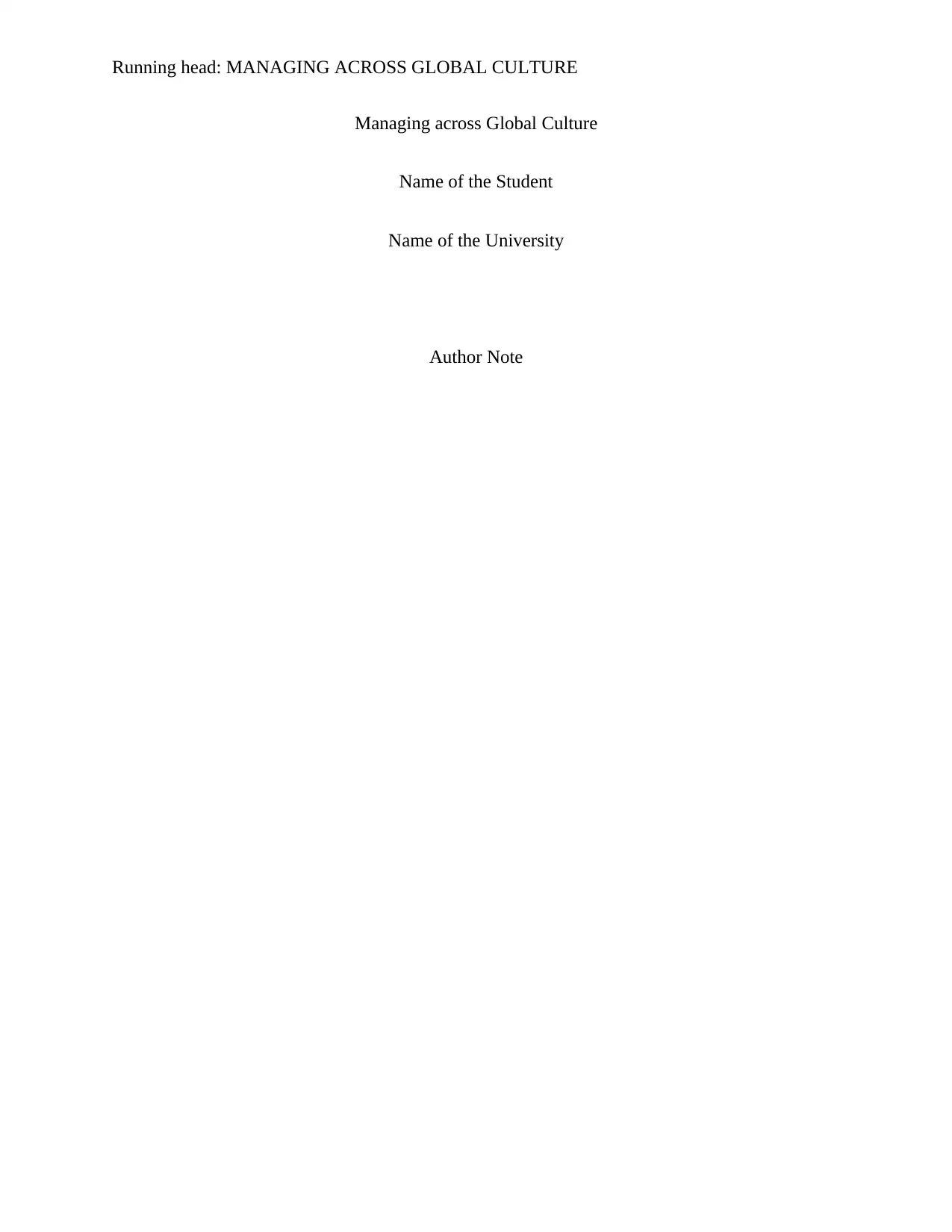
Running head: MANAGING ACROSS GLOBAL CULTURE
Managing across Global Culture
Name of the Student
Name of the University
Author Note
Managing across Global Culture
Name of the Student
Name of the University
Author Note
Paraphrase This Document
Need a fresh take? Get an instant paraphrase of this document with our AI Paraphraser
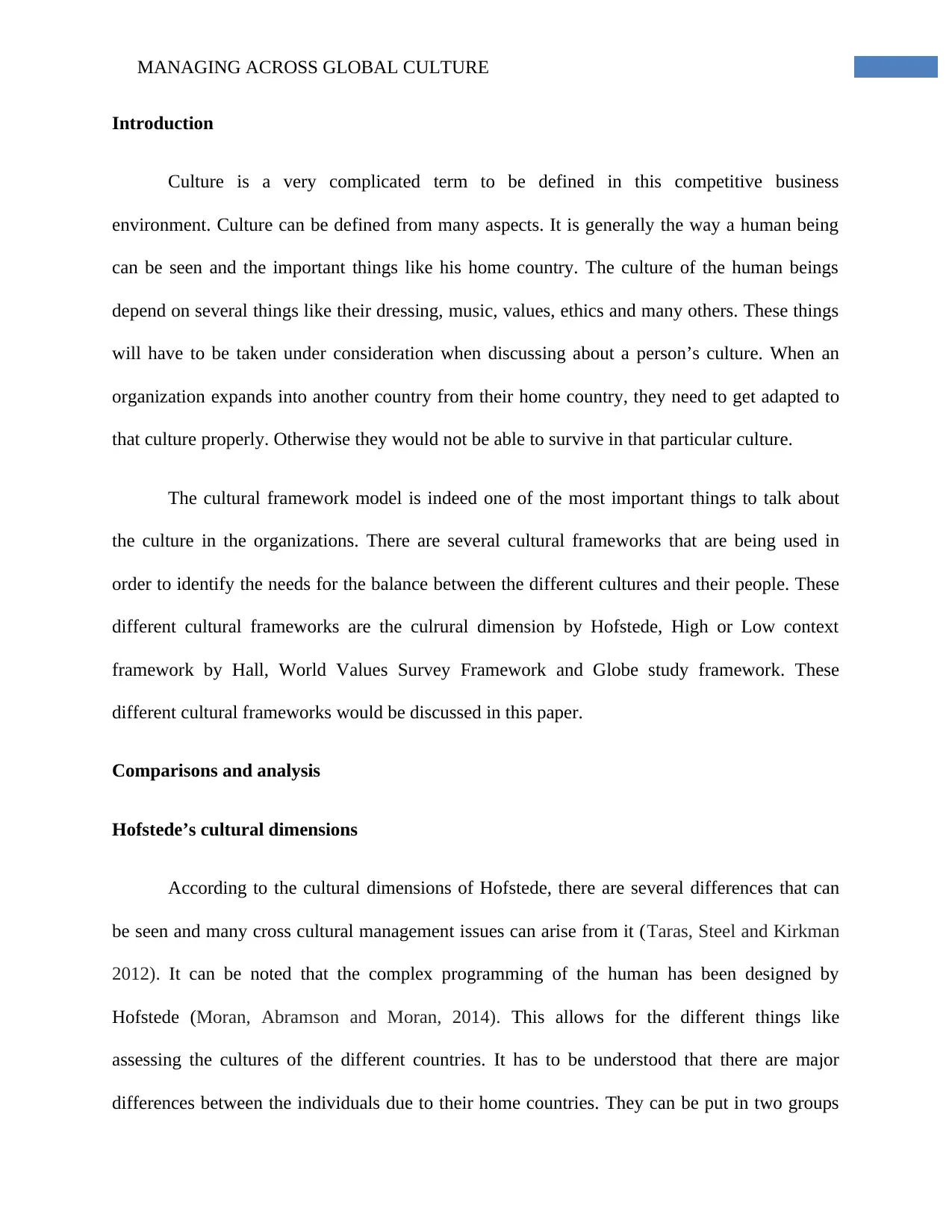
1MANAGING ACROSS GLOBAL CULTURE
Introduction
Culture is a very complicated term to be defined in this competitive business
environment. Culture can be defined from many aspects. It is generally the way a human being
can be seen and the important things like his home country. The culture of the human beings
depend on several things like their dressing, music, values, ethics and many others. These things
will have to be taken under consideration when discussing about a person’s culture. When an
organization expands into another country from their home country, they need to get adapted to
that culture properly. Otherwise they would not be able to survive in that particular culture.
The cultural framework model is indeed one of the most important things to talk about
the culture in the organizations. There are several cultural frameworks that are being used in
order to identify the needs for the balance between the different cultures and their people. These
different cultural frameworks are the culrural dimension by Hofstede, High or Low context
framework by Hall, World Values Survey Framework and Globe study framework. These
different cultural frameworks would be discussed in this paper.
Comparisons and analysis
Hofstede’s cultural dimensions
According to the cultural dimensions of Hofstede, there are several differences that can
be seen and many cross cultural management issues can arise from it (Taras, Steel and Kirkman
2012). It can be noted that the complex programming of the human has been designed by
Hofstede (Moran, Abramson and Moran, 2014). This allows for the different things like
assessing the cultures of the different countries. It has to be understood that there are major
differences between the individuals due to their home countries. They can be put in two groups
Introduction
Culture is a very complicated term to be defined in this competitive business
environment. Culture can be defined from many aspects. It is generally the way a human being
can be seen and the important things like his home country. The culture of the human beings
depend on several things like their dressing, music, values, ethics and many others. These things
will have to be taken under consideration when discussing about a person’s culture. When an
organization expands into another country from their home country, they need to get adapted to
that culture properly. Otherwise they would not be able to survive in that particular culture.
The cultural framework model is indeed one of the most important things to talk about
the culture in the organizations. There are several cultural frameworks that are being used in
order to identify the needs for the balance between the different cultures and their people. These
different cultural frameworks are the culrural dimension by Hofstede, High or Low context
framework by Hall, World Values Survey Framework and Globe study framework. These
different cultural frameworks would be discussed in this paper.
Comparisons and analysis
Hofstede’s cultural dimensions
According to the cultural dimensions of Hofstede, there are several differences that can
be seen and many cross cultural management issues can arise from it (Taras, Steel and Kirkman
2012). It can be noted that the complex programming of the human has been designed by
Hofstede (Moran, Abramson and Moran, 2014). This allows for the different things like
assessing the cultures of the different countries. It has to be understood that there are major
differences between the individuals due to their home countries. They can be put in two groups
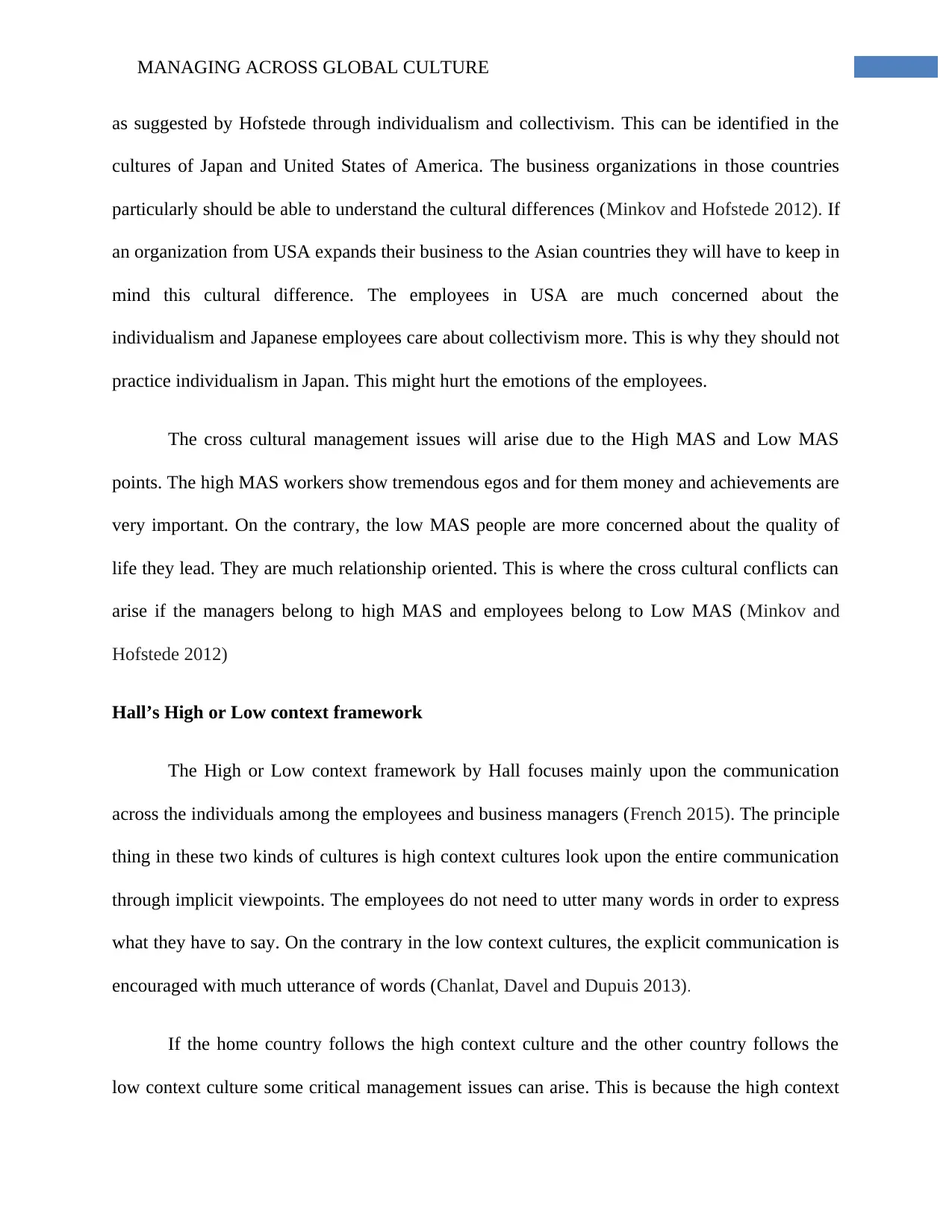
2MANAGING ACROSS GLOBAL CULTURE
as suggested by Hofstede through individualism and collectivism. This can be identified in the
cultures of Japan and United States of America. The business organizations in those countries
particularly should be able to understand the cultural differences (Minkov and Hofstede 2012). If
an organization from USA expands their business to the Asian countries they will have to keep in
mind this cultural difference. The employees in USA are much concerned about the
individualism and Japanese employees care about collectivism more. This is why they should not
practice individualism in Japan. This might hurt the emotions of the employees.
The cross cultural management issues will arise due to the High MAS and Low MAS
points. The high MAS workers show tremendous egos and for them money and achievements are
very important. On the contrary, the low MAS people are more concerned about the quality of
life they lead. They are much relationship oriented. This is where the cross cultural conflicts can
arise if the managers belong to high MAS and employees belong to Low MAS (Minkov and
Hofstede 2012)
Hall’s High or Low context framework
The High or Low context framework by Hall focuses mainly upon the communication
across the individuals among the employees and business managers (French 2015). The principle
thing in these two kinds of cultures is high context cultures look upon the entire communication
through implicit viewpoints. The employees do not need to utter many words in order to express
what they have to say. On the contrary in the low context cultures, the explicit communication is
encouraged with much utterance of words (Chanlat, Davel and Dupuis 2013).
If the home country follows the high context culture and the other country follows the
low context culture some critical management issues can arise. This is because the high context
as suggested by Hofstede through individualism and collectivism. This can be identified in the
cultures of Japan and United States of America. The business organizations in those countries
particularly should be able to understand the cultural differences (Minkov and Hofstede 2012). If
an organization from USA expands their business to the Asian countries they will have to keep in
mind this cultural difference. The employees in USA are much concerned about the
individualism and Japanese employees care about collectivism more. This is why they should not
practice individualism in Japan. This might hurt the emotions of the employees.
The cross cultural management issues will arise due to the High MAS and Low MAS
points. The high MAS workers show tremendous egos and for them money and achievements are
very important. On the contrary, the low MAS people are more concerned about the quality of
life they lead. They are much relationship oriented. This is where the cross cultural conflicts can
arise if the managers belong to high MAS and employees belong to Low MAS (Minkov and
Hofstede 2012)
Hall’s High or Low context framework
The High or Low context framework by Hall focuses mainly upon the communication
across the individuals among the employees and business managers (French 2015). The principle
thing in these two kinds of cultures is high context cultures look upon the entire communication
through implicit viewpoints. The employees do not need to utter many words in order to express
what they have to say. On the contrary in the low context cultures, the explicit communication is
encouraged with much utterance of words (Chanlat, Davel and Dupuis 2013).
If the home country follows the high context culture and the other country follows the
low context culture some critical management issues can arise. This is because the high context
⊘ This is a preview!⊘
Do you want full access?
Subscribe today to unlock all pages.

Trusted by 1+ million students worldwide
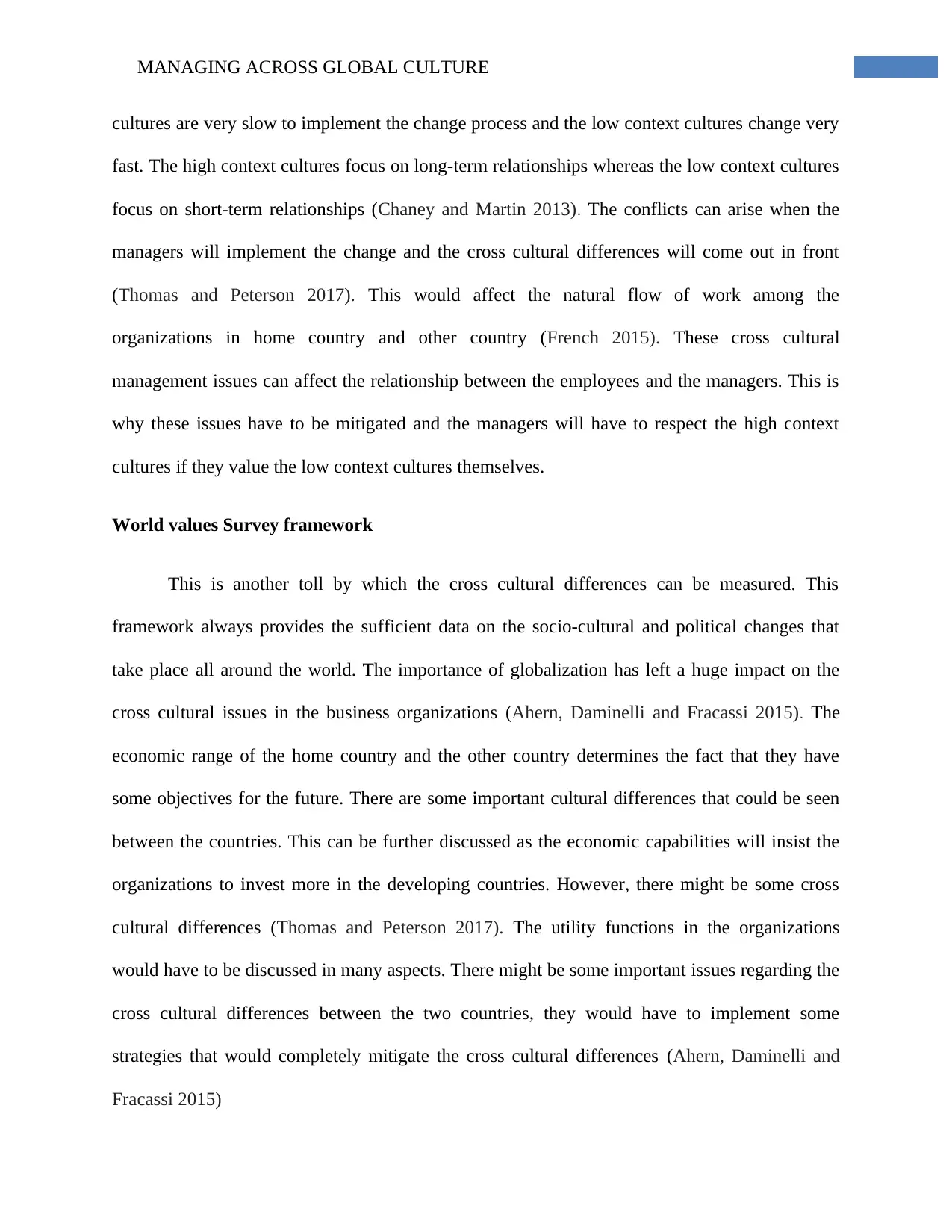
3MANAGING ACROSS GLOBAL CULTURE
cultures are very slow to implement the change process and the low context cultures change very
fast. The high context cultures focus on long-term relationships whereas the low context cultures
focus on short-term relationships (Chaney and Martin 2013). The conflicts can arise when the
managers will implement the change and the cross cultural differences will come out in front
(Thomas and Peterson 2017). This would affect the natural flow of work among the
organizations in home country and other country (French 2015). These cross cultural
management issues can affect the relationship between the employees and the managers. This is
why these issues have to be mitigated and the managers will have to respect the high context
cultures if they value the low context cultures themselves.
World values Survey framework
This is another toll by which the cross cultural differences can be measured. This
framework always provides the sufficient data on the socio-cultural and political changes that
take place all around the world. The importance of globalization has left a huge impact on the
cross cultural issues in the business organizations (Ahern, Daminelli and Fracassi 2015). The
economic range of the home country and the other country determines the fact that they have
some objectives for the future. There are some important cultural differences that could be seen
between the countries. This can be further discussed as the economic capabilities will insist the
organizations to invest more in the developing countries. However, there might be some cross
cultural differences (Thomas and Peterson 2017). The utility functions in the organizations
would have to be discussed in many aspects. There might be some important issues regarding the
cross cultural differences between the two countries, they would have to implement some
strategies that would completely mitigate the cross cultural differences (Ahern, Daminelli and
Fracassi 2015)
cultures are very slow to implement the change process and the low context cultures change very
fast. The high context cultures focus on long-term relationships whereas the low context cultures
focus on short-term relationships (Chaney and Martin 2013). The conflicts can arise when the
managers will implement the change and the cross cultural differences will come out in front
(Thomas and Peterson 2017). This would affect the natural flow of work among the
organizations in home country and other country (French 2015). These cross cultural
management issues can affect the relationship between the employees and the managers. This is
why these issues have to be mitigated and the managers will have to respect the high context
cultures if they value the low context cultures themselves.
World values Survey framework
This is another toll by which the cross cultural differences can be measured. This
framework always provides the sufficient data on the socio-cultural and political changes that
take place all around the world. The importance of globalization has left a huge impact on the
cross cultural issues in the business organizations (Ahern, Daminelli and Fracassi 2015). The
economic range of the home country and the other country determines the fact that they have
some objectives for the future. There are some important cultural differences that could be seen
between the countries. This can be further discussed as the economic capabilities will insist the
organizations to invest more in the developing countries. However, there might be some cross
cultural differences (Thomas and Peterson 2017). The utility functions in the organizations
would have to be discussed in many aspects. There might be some important issues regarding the
cross cultural differences between the two countries, they would have to implement some
strategies that would completely mitigate the cross cultural differences (Ahern, Daminelli and
Fracassi 2015)
Paraphrase This Document
Need a fresh take? Get an instant paraphrase of this document with our AI Paraphraser
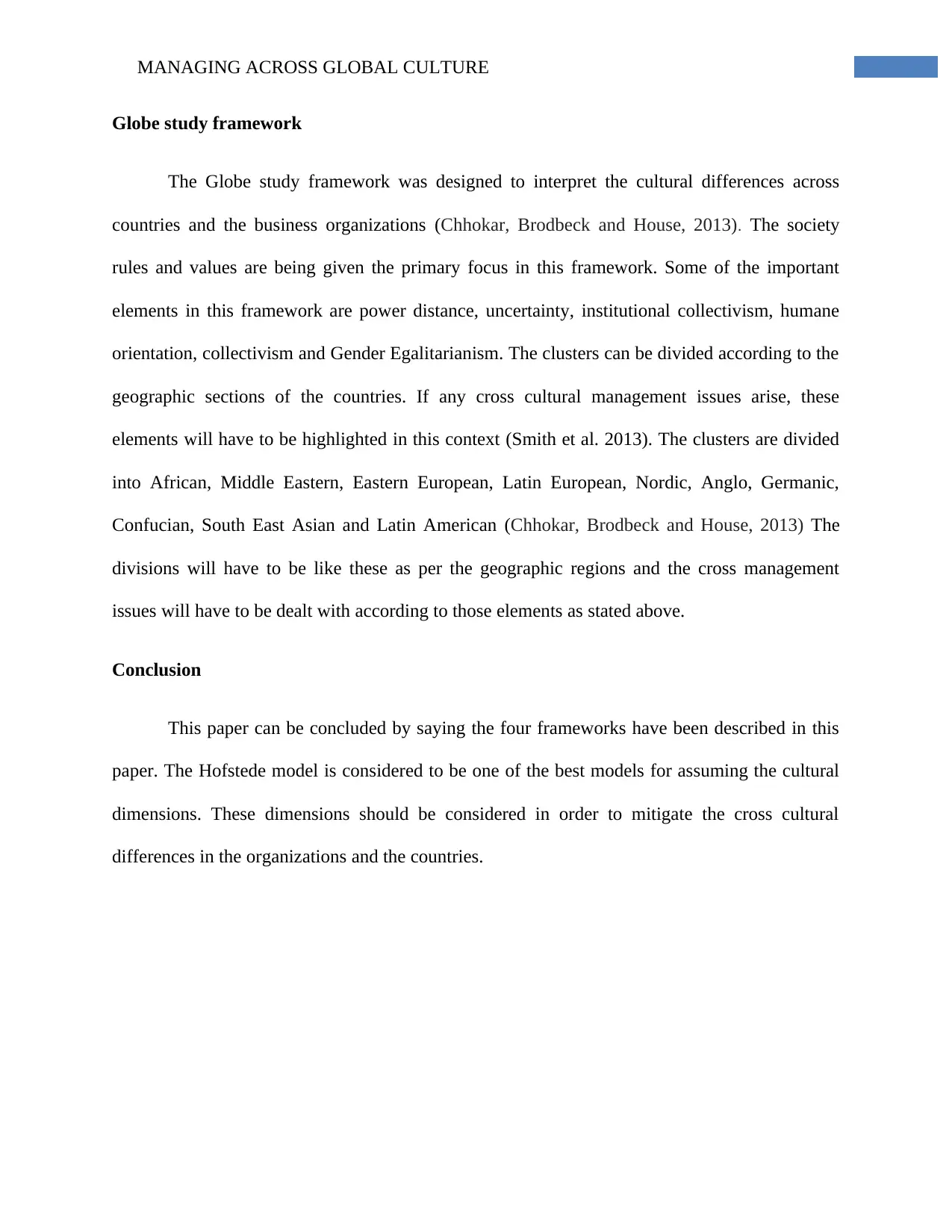
4MANAGING ACROSS GLOBAL CULTURE
Globe study framework
The Globe study framework was designed to interpret the cultural differences across
countries and the business organizations (Chhokar, Brodbeck and House, 2013). The society
rules and values are being given the primary focus in this framework. Some of the important
elements in this framework are power distance, uncertainty, institutional collectivism, humane
orientation, collectivism and Gender Egalitarianism. The clusters can be divided according to the
geographic sections of the countries. If any cross cultural management issues arise, these
elements will have to be highlighted in this context (Smith et al. 2013). The clusters are divided
into African, Middle Eastern, Eastern European, Latin European, Nordic, Anglo, Germanic,
Confucian, South East Asian and Latin American (Chhokar, Brodbeck and House, 2013) The
divisions will have to be like these as per the geographic regions and the cross management
issues will have to be dealt with according to those elements as stated above.
Conclusion
This paper can be concluded by saying the four frameworks have been described in this
paper. The Hofstede model is considered to be one of the best models for assuming the cultural
dimensions. These dimensions should be considered in order to mitigate the cross cultural
differences in the organizations and the countries.
Globe study framework
The Globe study framework was designed to interpret the cultural differences across
countries and the business organizations (Chhokar, Brodbeck and House, 2013). The society
rules and values are being given the primary focus in this framework. Some of the important
elements in this framework are power distance, uncertainty, institutional collectivism, humane
orientation, collectivism and Gender Egalitarianism. The clusters can be divided according to the
geographic sections of the countries. If any cross cultural management issues arise, these
elements will have to be highlighted in this context (Smith et al. 2013). The clusters are divided
into African, Middle Eastern, Eastern European, Latin European, Nordic, Anglo, Germanic,
Confucian, South East Asian and Latin American (Chhokar, Brodbeck and House, 2013) The
divisions will have to be like these as per the geographic regions and the cross management
issues will have to be dealt with according to those elements as stated above.
Conclusion
This paper can be concluded by saying the four frameworks have been described in this
paper. The Hofstede model is considered to be one of the best models for assuming the cultural
dimensions. These dimensions should be considered in order to mitigate the cross cultural
differences in the organizations and the countries.
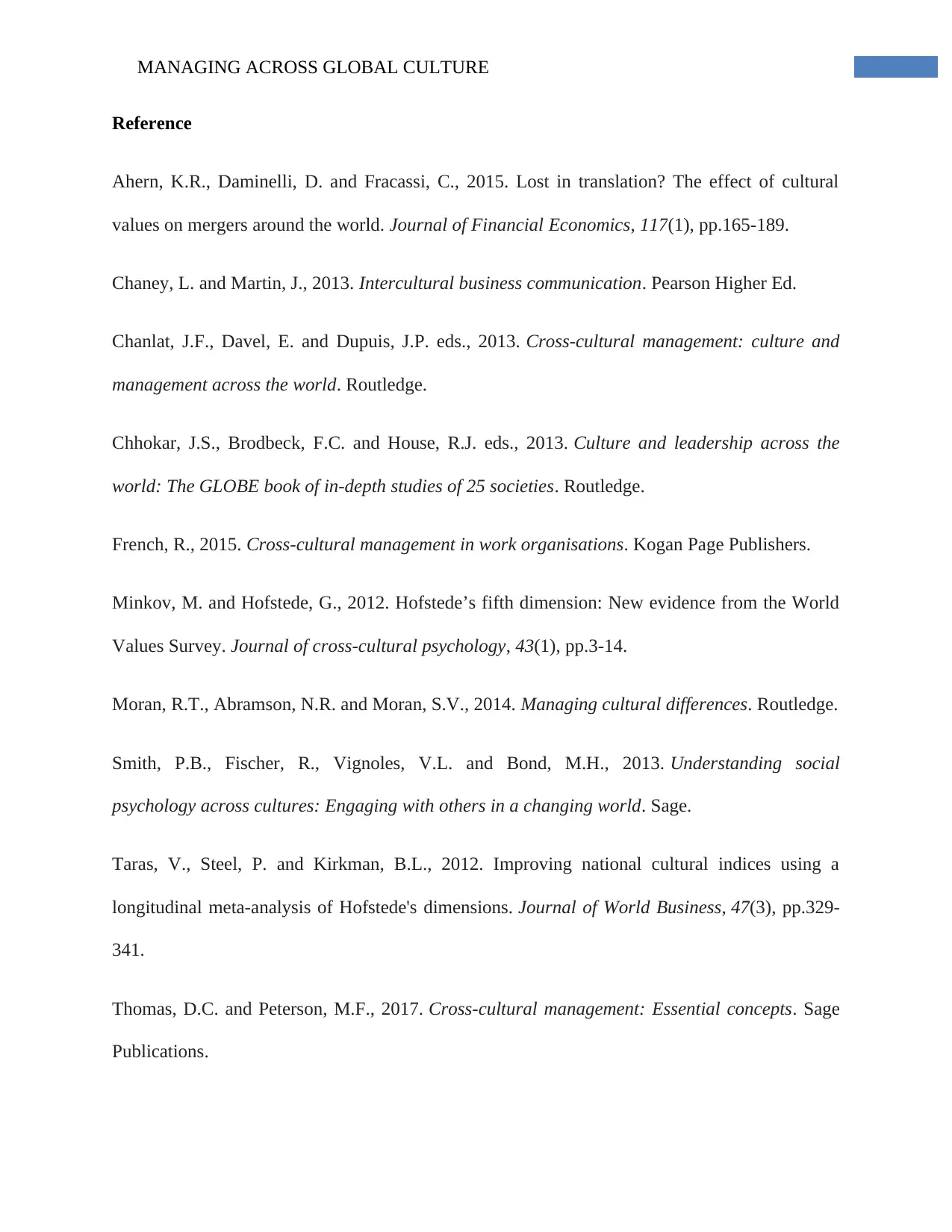
5MANAGING ACROSS GLOBAL CULTURE
Reference
Ahern, K.R., Daminelli, D. and Fracassi, C., 2015. Lost in translation? The effect of cultural
values on mergers around the world. Journal of Financial Economics, 117(1), pp.165-189.
Chaney, L. and Martin, J., 2013. Intercultural business communication. Pearson Higher Ed.
Chanlat, J.F., Davel, E. and Dupuis, J.P. eds., 2013. Cross-cultural management: culture and
management across the world. Routledge.
Chhokar, J.S., Brodbeck, F.C. and House, R.J. eds., 2013. Culture and leadership across the
world: The GLOBE book of in-depth studies of 25 societies. Routledge.
French, R., 2015. Cross-cultural management in work organisations. Kogan Page Publishers.
Minkov, M. and Hofstede, G., 2012. Hofstede’s fifth dimension: New evidence from the World
Values Survey. Journal of cross-cultural psychology, 43(1), pp.3-14.
Moran, R.T., Abramson, N.R. and Moran, S.V., 2014. Managing cultural differences. Routledge.
Smith, P.B., Fischer, R., Vignoles, V.L. and Bond, M.H., 2013. Understanding social
psychology across cultures: Engaging with others in a changing world. Sage.
Taras, V., Steel, P. and Kirkman, B.L., 2012. Improving national cultural indices using a
longitudinal meta-analysis of Hofstede's dimensions. Journal of World Business, 47(3), pp.329-
341.
Thomas, D.C. and Peterson, M.F., 2017. Cross-cultural management: Essential concepts. Sage
Publications.
Reference
Ahern, K.R., Daminelli, D. and Fracassi, C., 2015. Lost in translation? The effect of cultural
values on mergers around the world. Journal of Financial Economics, 117(1), pp.165-189.
Chaney, L. and Martin, J., 2013. Intercultural business communication. Pearson Higher Ed.
Chanlat, J.F., Davel, E. and Dupuis, J.P. eds., 2013. Cross-cultural management: culture and
management across the world. Routledge.
Chhokar, J.S., Brodbeck, F.C. and House, R.J. eds., 2013. Culture and leadership across the
world: The GLOBE book of in-depth studies of 25 societies. Routledge.
French, R., 2015. Cross-cultural management in work organisations. Kogan Page Publishers.
Minkov, M. and Hofstede, G., 2012. Hofstede’s fifth dimension: New evidence from the World
Values Survey. Journal of cross-cultural psychology, 43(1), pp.3-14.
Moran, R.T., Abramson, N.R. and Moran, S.V., 2014. Managing cultural differences. Routledge.
Smith, P.B., Fischer, R., Vignoles, V.L. and Bond, M.H., 2013. Understanding social
psychology across cultures: Engaging with others in a changing world. Sage.
Taras, V., Steel, P. and Kirkman, B.L., 2012. Improving national cultural indices using a
longitudinal meta-analysis of Hofstede's dimensions. Journal of World Business, 47(3), pp.329-
341.
Thomas, D.C. and Peterson, M.F., 2017. Cross-cultural management: Essential concepts. Sage
Publications.
⊘ This is a preview!⊘
Do you want full access?
Subscribe today to unlock all pages.

Trusted by 1+ million students worldwide

6MANAGING ACROSS GLOBAL CULTURE
1 out of 7
Related Documents
Your All-in-One AI-Powered Toolkit for Academic Success.
+13062052269
info@desklib.com
Available 24*7 on WhatsApp / Email
![[object Object]](/_next/static/media/star-bottom.7253800d.svg)
Unlock your academic potential
Copyright © 2020–2025 A2Z Services. All Rights Reserved. Developed and managed by ZUCOL.





